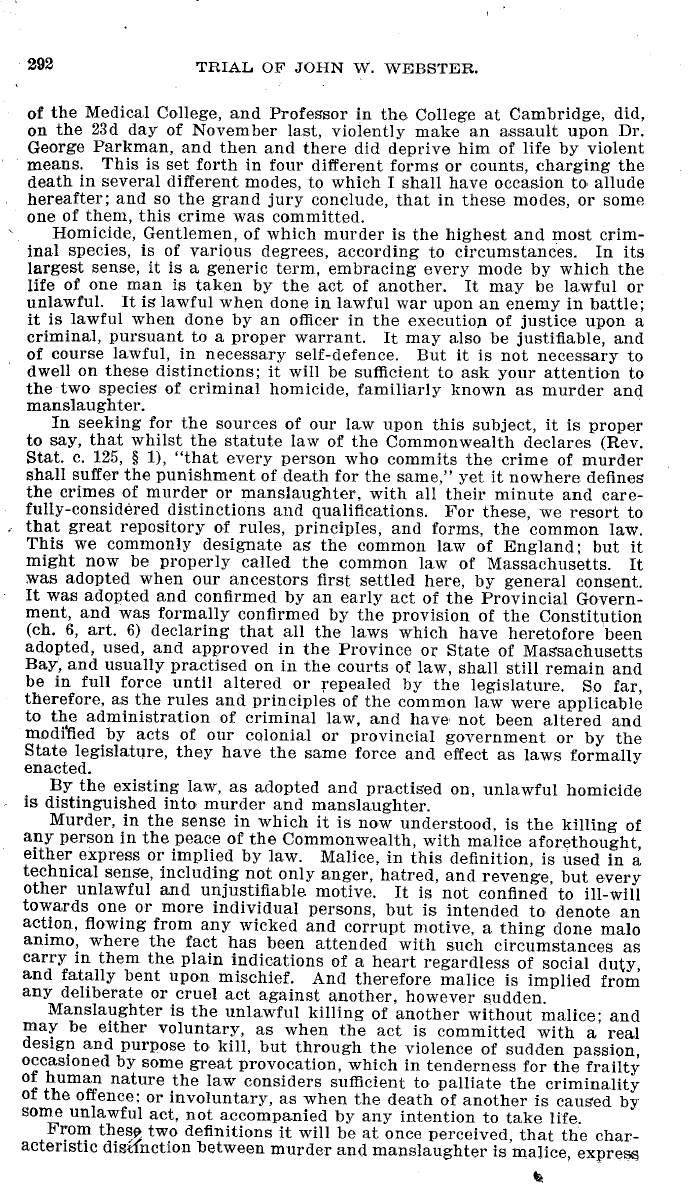|
292 TRIAL OF JOHN W. WEBSTER.
of the Medical College, and Professor in the College at Cambridge, did,
on the 23d day of November last, violently make an assault upon Dr.
George Parkman, and then and there did deprive him of life by violent
means. This is set forth in four different forms or counts, charging the
death in several different modes, to which I shall have occasion to allude
hereafter; and so the grand jury conclude, that in these modes, or some
one of them, this crime was committed.
Homicide, Gentlemen, of which murder is the highest and most crim-
inal species, is of various degrees, according to circumstances. In its
largest sense, it is a generic term, embracing every mode by which the
life of one man is taken by the act of another. It may be lawful or
unlawful. It is lawful when done in lawful war upon an enemy in battle;
it is lawful when done by an officer in the execution of justice upon a
criminal, pursuant to a proper warrant. It may also be justifiable, and
of course lawful, in necessary self-defence. But it is not necessary to
dwell on these distinctions; it will be sufficient to ask your attention to
the two species of criminal homicide, familiarly known as murder and
manslaughter.
In seeking for the sources of our law upon this subject, it is proper
to say, that whilst the statute law of the Commonwealth declares (Rev.
Stat. c. 125, § 1), "that every person who commits the crime of murder
shall suffer the punishment of death for the same," yet it nowhere defines
the crimes of murder or manslaughter, with all their minute and care-
fully-considered distinctions and qualifications. For these, we resort to
that great repository of rules, principles, and forms, the common law.
This we commonly designate as the common law of England; but it
might now be properly called the common law of Massachusetts. It
was adopted when our ancestors first settled here, by general consent.
It was adopted and confirmed by an early act of the Provincial Govern-
ment, and was formally confirmed by the provision of the Constitution
(ch. 6, art. 6) declaring that all the laws which have heretofore been
adopted, used, and approved in the Province or State of Massachusetts
Bay, and usually practised on in the courts of law, shall still remain and
be in full force until altered or repealed by the legislature. So far,
therefore, as the rules and principles of the common law were applicable
to the administration of criminal law, and have not been altered and
modified by acts of our colonial or provincial government or by the
State legislature, they have the same force and effect as laws formally
enacted.
By the existing law, as adopted and practised on, unlawful homicide
is distinguished into murder and manslaughter.
Murder, in the sense in which it is now understood, is the killing of
any person in the peace of the Commonwealth, with malice aforethought,
either express or implied by law. Malice, in this definition, is used in a
technical sense, including not only anger, hatred, and revenge, but every
other unlawful and unjustifiable motive. It is not confined to ill-will
towards one or more individual persons, but is intended to denote an
action, flowing from any wicked and corrupt motive, a thing done malo
animo, where the fact has been attended with such circumstances as
carry in them the plain indications of a heart regardless of social duty,
and fatally bent upon mischief. And therefore malice is implied from
any deliberate or cruel act against another, however sudden.
Manslaughter is the unlawful killing of another without malice; and
may be either voluntary, as when the act is committed with a real
design and purpose to kill, but through the violence of sudden passion,
occasioned by some great provocation, which in tenderness for the frailty
of human nature the law considers sufficient to- palliate the criminality
of the offence; or involuntary, as when the death of another is caused by
some unlawful act, not accompanied by any intention to take life.
From thess two definitions it will be at once perceived, that the char-
acteristic disi-unction between murder and manslaughter is malice, expresq
|

